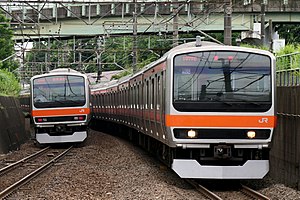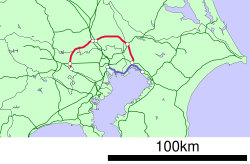
Back Musashino-Linie German خط موساشینو Persian Ligne Musashino French Jalur Musashino ID Linea Musashino Italian 武蔵野線 Japanese 무사시노선 Korean Линия Мусасино Russian Linyang Musashino Tagalog Tuyến Musashino Vietnamese
| Musashino Line | |||
|---|---|---|---|
| JM | |||
 Musashino Line E231 series EMUs, November 2019 | |||
| Overview | |||
| Native name | 武蔵野線 | ||
| Owner | JR East | ||
| Locale | Tokyo, Kanagawa, Saitama, Chiba prefectures | ||
| Termini | |||
| Stations | 26 | ||
| Service | |||
| Type | Heavy rail | ||
| Operator(s) | |||
| Depot(s) | Keiyo | ||
| Rolling stock | 209-500 series, E231-0 series, E231-900 series EMUs | ||
| Daily ridership | 1,064,613 (daily 2015)[1] | ||
| History | |||
| Opened | 1973 | ||
| Technical | |||
| Line length | 71.8 km (44.6 mi) (passenger operations) 100.6 km (62.5 mi) (Total) | ||
| Track gauge | 1,067 mm (3 ft 6 in) | ||
| Electrification | 1,500 V DC overhead catenary | ||
| |||
The Musashino Line (武蔵野線, Musashino-sen) is a railway line operated by the East Japan Railway Company (JR East). It links Tsurumi Station in Yokohama with Nishi-Funabashi Station in Chiba Prefecture, forming a 100.6 km (62.5 mi) unclosed loop around central Tokyo. Passenger operations are limited to the 71.8 km (44.6 mi) portion between Fuchūhommachi and Nishi-Funabashi; the Tsurumi to Fuchūhommachi portion, called the "Musashino South Line", is normally used only by freight trains. The line forms part of what JR East refers to as the "Tokyo Mega Loop" (Japanese: 東京メガループ) around Tokyo, consisting of the Keiyō Line, Musashino Line, Nambu Line, and Yokohama Line.[2]
- ^ "平成27年 大都市交通センサス 首都圏報告書" (PDF). P.92. 国土交通省.
- ^ Saka, Masayuki (August 2014). 東京メガループ 車両・路線の沿革と現況 [Tokyo Megaloop: History and current situation of trains and line]. Tetsudō Daiya Jōhō Magazine (in Japanese). Vol. 43, no. 364. Japan: Kōtsū Shimbun. pp. 28–39.

